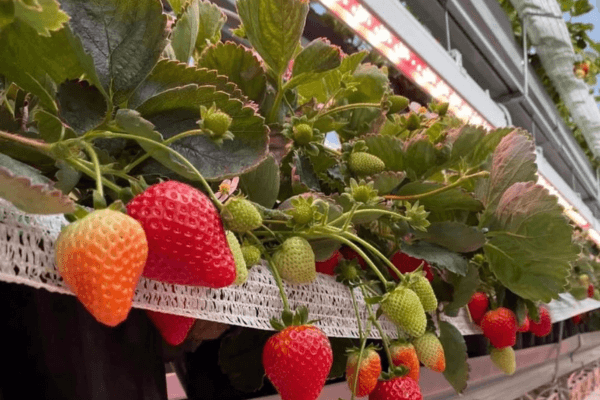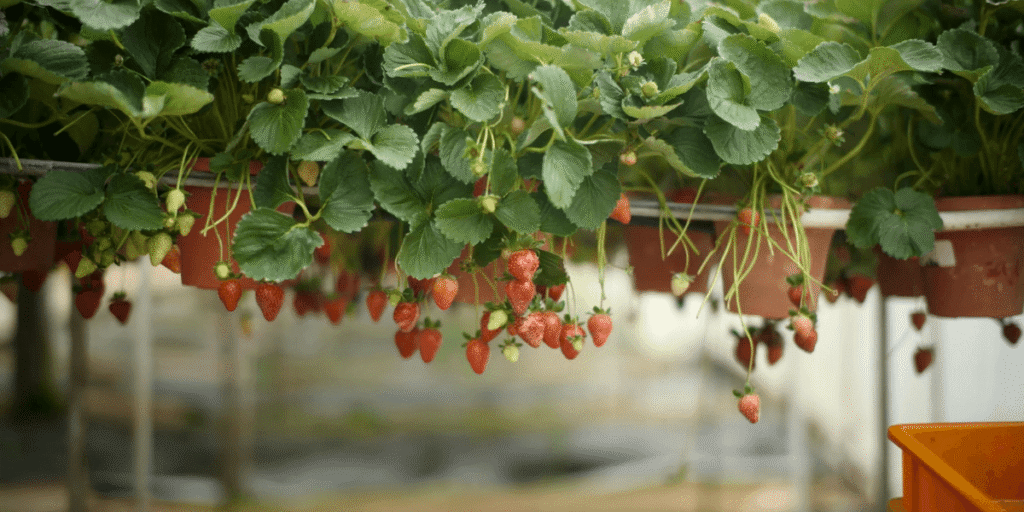Grow strawberries hydroponically and enjoy sweet, juicy berries all year round right from the comfort of your home without ever touching soil. This isn’t just a dream; with hydroponic strawberry cultivation, it’s completely achievable. This innovative soilless growing method offers an efficient, clean, and incredibly rewarding way to become a strawberry expert even if you have limited space. If you’re looking for indoor strawberry growing tips or want to find the best hydroponic system for strawberries, you’re in the right place.
This comprehensive guide will explore everything you need to know about growing hydroponic strawberries, from the basics to advanced techniques, helping you go beyond traditional gardening and start your own fruitful journey.
Grow Strawberry Hydroponically: Your Step-by-Step Beginner Guide
Hydroponics is an innovative way of growing plants without soil. Instead of relying on dirt, plants receive all their essential nutrients through a carefully balanced solution dissolved in water. For strawberries, this means their roots are bathed directly in a nutrient-rich environment, allowing them to absorb exactly what they need for healthy growth and sweet fruit production.
This soilless method offers a cleaner, more efficient way to cultivate strawberries, especially for home gardeners who want fresh berries but may not have access to garden space or high-quality soil. By precisely controlling the water, nutrients, and growing conditions, hydroponics eliminates many common problems like soil-borne pests, diseases, and weeds. The result? Faster growth, less maintenance, and the exciting possibility of enjoying delicious, homegrown strawberries all year round, regardless of outdoor weather. It’s no wonder that hydroponic strawberry cultivation is quickly becoming a favorite among indoor gardening enthusiasts looking to bring a little sweetness into their homes.
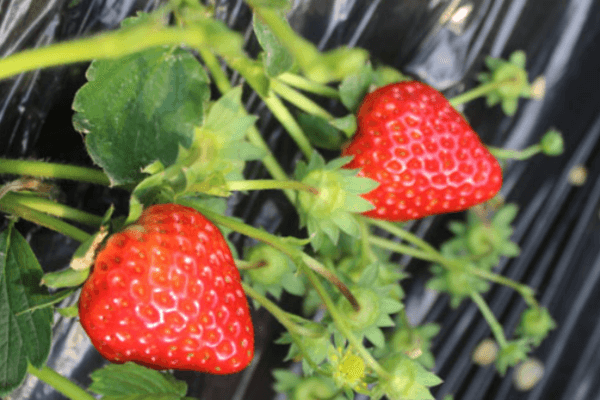
Why Hydroponic Strawberry Growing Beats Traditional Gardening
Growing strawberries hydroponically comes with a host of benefits that traditional soil gardening just can’t match:
- No Soil, No Problem: By ditching soil altogether, you avoid many common pests and diseases that live in the ground like nematodes or fusarium wilt. Plus, you won’t have to deal with pesky weeds popping up all the time. Your indoor garden stays clean, tidy, and much easier to manage. This simplifies pest control for hydroponic strawberries.
- Less Pest Trouble: Because hydroponic systems are usually indoors or in controlled environments, you’ll see far fewer flying insects and bugs. This means pest management becomes simpler and less stressful no more constant battles with aphids or fruit flies.
- Super Water Efficient: Hydroponics recycles water within the system, so you use up to 90% less water than traditional gardening methods. It’s a win-win: better for the planet and kinder on your water bill. This makes hydroponic gardening sustainable.
- Make the Most of Small Spaces: If you live in a city apartment or don’t have a big yard, hydroponics lets you grow strawberries vertically, making use of even the smallest balcony or corner. Vertical towers turn limited space into a lush, productive garden, perfect for urban farming.
- Easy, Enjoyable Harvests: With strawberries growing up at eye level, picking your fresh berries becomes a breeze. No bending or digging just reach out and grab your sweet rewards. Hydroponic harvesting is truly effortless.
- Fresh Strawberries All Year Round: Thanks to controlled indoor conditions, you’re not tied to the seasons anymore. Whether it’s summer or winter outside, you can enjoy homegrown strawberries anytime you crave them. This is ideal for winter strawberry growing and continuous yields.
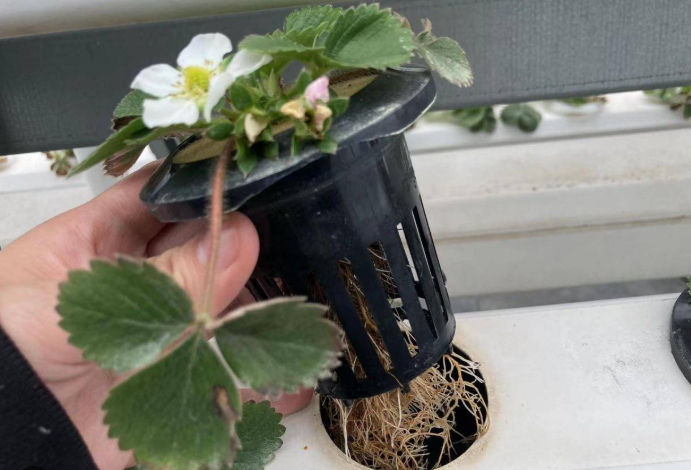
What to Know Before Starting a Soil-Free Strawberry Setup
Like any gardening method, hydroponics has its own set of challenges. Knowing what to expect beforehand will help you start your hydroponic journey with confidence:
- Initial Investment: Setting up a hydroponic system including pumps, tubing, containers, and LED grow lights can cost more upfront than traditional soil gardening. But over time, the efficiency and steady harvests usually make it a worthwhile investment for sustainable, long-term growing.
- Learning Curve: Hydroponics for beginners requires careful attention to details like water quality, nutrient mixes, and pH balance. If you’re new to this, it might take a little time to get the hang of these technical aspects. Luckily, there are plenty of online tutorials, forums, and handy tools to guide you step by step, making the hydroponic learning process much smoother.
- Per-Plant Yield: Sometimes, hydroponic strawberries produce slightly less fruit per plant compared to perfect soil conditions. However, since you can grow many plants year-round indoors, your total harvest often ends up much higher overall, compensating for any per-plant difference.
- Dependence on Electricity: Hydroponic systems rely on pumps and grow lights powered by electricity. If the power goes out unexpectedly, your plants could suffer. It’s smart to have a backup plan or keep a close eye on your system to avoid surprises, especially for indoor grow setups.
- Ongoing Maintenance: While hydroponics is cleaner than soil gardening, the system still needs regular care. Check pumps, clear any clogs, and monitor nutrient levels consistently. Don’t forget to clean your reservoir and pipes often to keep algae at bay and ensure optimal hydroponic system hygiene.
Essential Tools to Build a Productive Indoor Strawberry Garden
If you’re ready to dive into growing strawberries hydroponically, you’ll want a few key pieces of equipment. Picking the right hydroponic setup for strawberries makes all the difference for a successful harvest.
Hydroponic Strawberry Systems: Choosing the Right Type for You
- Growing Tray/Channels: These are where your strawberry plants live. Nutrient solution flows through them to feed the roots. Popular systems include Nutrient Film Technique (NFT), Deep Water Culture (DWC), and drip systems. For strawberry hydroponics, NFT setups and vertical towers are often favorites. They’re efficient and space-saving.
- Reservoir: This container holds your nutrient-rich water. Make sure it’s opaque. This prevents light from getting in, which helps stop algae growth and keeps your system clean.
- Water Pump: The pump moves the nutrient solution from the reservoir through the growing trays. This ensures your plants get a steady supply of nutrients.
- Air Pump and Air Stone: If you’re using a DWC system, these help oxygenate the water. This is crucial for healthy strawberry roots and avoiding root rot.
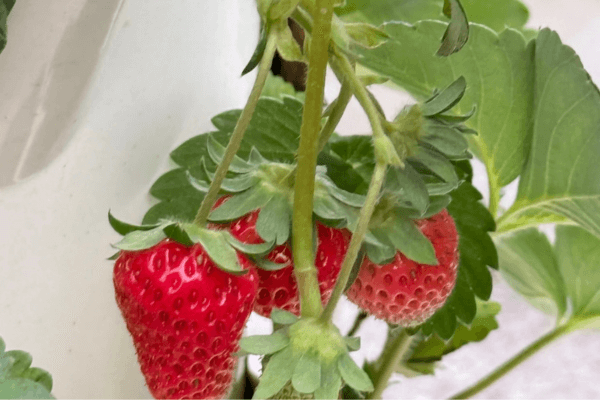
Feeding and Supporting Strawberries in a Hydroponic Setup
- Growing Media: No soil here! You’ll need an inert medium. Options include coco coir, perlite, or rockwool. These support plants and retain moisture. Coco coir is popular for beginners. It’s easy to work with and holds water well, making it ideal for strawberry growing media.
- Hydroponic Nutrient Solutions: Look for liquid nutrients made specifically for hydroponics. You might need separate formulas for the vegetative stage and fruiting stage, or a good all-purpose mix. Ensure the nutrients suit strawberries for best results. You’ll often search for strawberry hydroponic fertilizer.
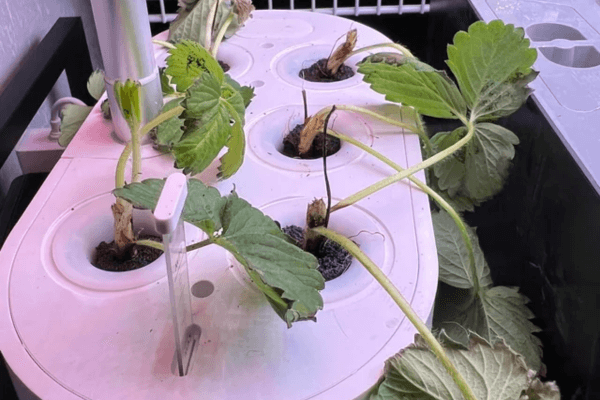
Lighting and Monitoring Tips for Healthy Strawberry Plants Indoors
- pH Meter and Adjusters: Keeping your nutrient solution’s pH in the sweet spot between 5.8 and 6.2 is vital. A good pH meter monitors this easily. Use pH up/down solutions to adjust as needed. This is crucial for nutrient uptake in hydroponics.
- Lighting: Growing indoors? Quality LED grow lights are a must. Full-spectrum LEDs designed for fruiting plants provide needed light. Your strawberries will thrive and produce sweet, juicy berries. Consider hydroponic lighting schedules carefully.
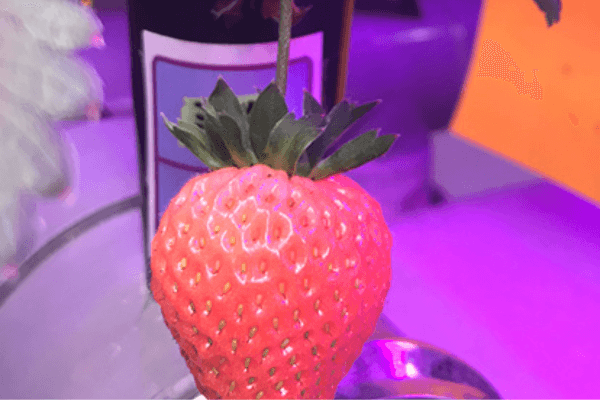
- Net Pots: These small plastic baskets hold plants and growing media securely inside your hydroponic system.
How to Manage Temperature and Humidity in Your Strawberry Grow Room
Once your hydroponic setup is ready, the next step is to create the ideal conditions to help your hydroponic strawberries flourish and produce plenty of delicious fruit:
- Planting Technique: For quicker and more reliable results, it’s best to start with young strawberry plants like runners or bare-root plants instead of seeds. Seeds take much longer to grow and fruit, and their germination can be unpredictable. Simply place your young plant gently into a net pot filled with your chosen growing media.
- Light & Temperature: Strawberries thrive in temperatures between 65 and 80°F (18 to 27°C). They also need about 8 to 12 hours of light each day, preferably from a full-spectrum LED grow light. Consistent, good-quality lighting is key to encouraging flowering and juicy fruit development. Optimal hydroponic temperature control is important.
- Water Quality & pH: Water quality is absolutely crucial in hydroponics. Use clean water; filtered or reverse osmosis (RO) water works best to avoid impurities. Keep your pH steady between 5.8 and 6.2 by checking regularly with a pH meter and adjusting with pH up or down solutions as needed. Stable pH ensures your strawberries can absorb nutrients efficiently, preventing nutrient lockout.
- Nutrient Solutions: Choose a high-quality liquid nutrient formula made for fruiting plants. Follow the instructions carefully, adjusting the mix depending on whether your plants are still growing leaves or are in the flowering and fruiting stage. For beginners, pre-mixed nutrient solutions are a great way to start. Don’t forget to monitor the EC (Electrical Conductivity) to keep track of nutrient strength, ensuring your plants get the right amount of food.
Pollinating Indoor Strawberry Plants for Bigger and Better Yields
Since there won’t be any bees flying around your indoor garden, you’ll need to take a hands-on approach to pollinate your hydroponic strawberries. This step is essential for getting those beautiful berries to form.
A simple way to do this is by using a small, soft brush like a tiny paintbrush to gently transfer pollen from one flower to another. Alternatively, you can lightly shake the plants to help release the pollen. Doing this every day or every other day during the flowering period can make a big difference, boosting both the number of fruits and the overall harvest. If you want to dive deeper into hydroponic pollination techniques, check out our detailed guide: How Are Hydroponic Plants Pollinated?
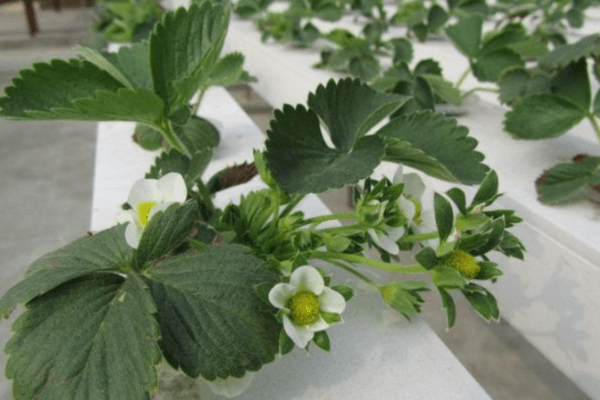
Fixing Common Problems in Hydroponic Strawberry Cultivation
Even experienced growers encounter issues. Here are some common problems and solutions for your hydroponic strawberry plants:
- Nutrient/pH Imbalances: Wilting, discolored leaves (e.g., yellowing, browning edges), or stunted growth can often point to incorrect pH or nutrient deficiencies/toxicities. Regularly monitor your pH and EC to catch issues early. Adjustments to your nutrient solution formulation or pH are usually the fix.
- Pests & Diseases: While less common than in soil, aphids, spider mites, or fungal issues like powdery mildew can still arise in indoor hydroponics. Inspect your plants regularly. Use organic pest control methods like neem oil spray or introduce beneficial insects if needed. Ensure good air circulation (with fans) and proper humidity to prevent fungal problems and improve hydroponic plant health.
- Algae Growth: Green slime in your reservoir or on media is usually algae, caused by light exposure. Keep your reservoir opaque and clean to prevent this common hydroponic issue.
FAQ: Everything You Wondered About Growing Strawberries Indoors
Q1: My strawberries are flowering but not making any fruit. What’s going on?
A: Since you’re growing indoors, there aren’t any bees to pollinate. You’ll need to manually pollinate by gently brushing pollen between flowers or giving the plants a light shake every day during flowering.
Q2: The leaves on my strawberry plants are turning yellow. Is something wrong?
A: Yellow leaves usually mean either a nutrient problem or your water’s pH is off. Check that your pH is between 5.8 and 6.2, and make sure your nutrient solution strength (EC) matches the growth stage.
Q3: How often should I change the nutrient solution?
A: Change it every 1 to 2 weeks. Even if you top it off, the balance of nutrients shifts over time, so fresh solution helps keep your plants healthy.
Q4: My hydroponic strawberries don’t taste as good as garden-grown ones. Why?
A: Flavor depends a lot on light and nutrients. Make sure your plants get enough bright light (8–12 hours daily). Also, during fruiting, try lowering nitrogen and increasing phosphorus and potassium to improve sweetness.
Q5: Can I use tap water for my hydroponic system?
A: It depends on your tap water quality. If it’s hard or has chlorine, it’s better to use filtered or RO water to keep nutrient and pH levels stable.
How to Boost Strawberry Yield Using Smart Hydroponic Techniques
Once you’ve got the hang of growing strawberry hydroponically, there’s a whole world of other easy-to-grow plants waiting for you to explore. From leafy greens to herbs and more, these beginner-friendly options can help you expand your indoor garden with confidence. Check out our guide, 12 Easy Hydroponic Plants for Beginners, to discover new ideas and tips for your next hydroponic adventure. It’s the perfect resource to help you build your skills and create a thriving, diverse garden.
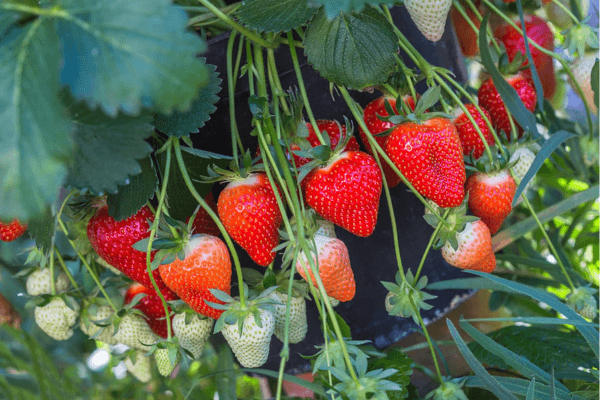
Shop Hydroponic Kits and Lights to Grow Strawberries Indoors
Imagine plucking sweet, juicy strawberries fresh from your own indoor garden anytime, any season. Growing strawberries hydroponically makes this dream a reality. Whether you’re starting with a cozy countertop setup or planning a lush vertical garden, hydroponics allows you to grow more in less space, use less water, and avoid the mess of soil.
While it requires a bit more upfront investment and a steeper learning curve than traditional gardening, the benefits from year-round fresh fruit to efficient resource use and cleaner growing far outweigh the challenges. By understanding the essential components, maintaining optimal environmental conditions, and proactively addressing potential issues, you’ll be well on your way to a continuous supply of delicious, homegrown strawberries.
Our step-by-step guide walks you through everything you need from choosing the best strawberry varieties to building your system and mastering the care your plants crave. Paired with our energy-efficient LED grow lights and easy-to-use hydroponic kits, growing strawberries becomes a joyful and rewarding experience.
Already nurturing your own hydroponic strawberries? Share your success stories with us. Tag @Greenfuturehydro on Instagram. We love celebrating your harvests and are here to support you every step of the way.
